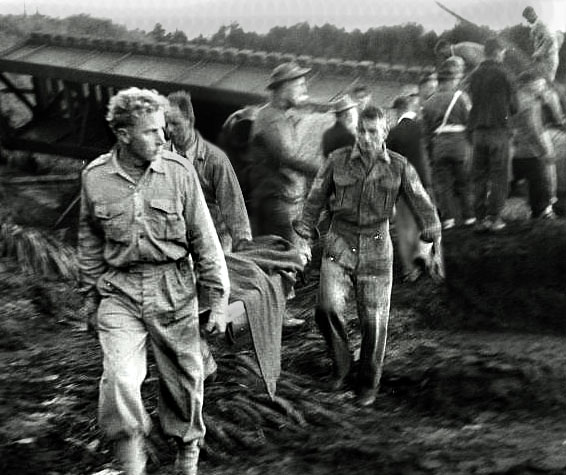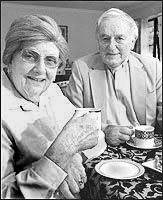24. - The Angel of Tangiwai
Nursing
Sister Lt Theresa Mortimer (later Mrs Holder) was the
unsung Angel of Tangiwai.
On Christmas Eve 1953, Waiouru Camp chaplain
Father Tom Duffy and three of his congregation, Sister
Mortimer, medical officer Dr Fraser MacDonald, and duty
officer Lt Irene Hanman (later Mrs Rollo), were keeping each
other company while staying up for Midnight Mass. Just
before 10pm they heard a strange sound like rolling thunder
from out towards the Karioi forest. Then half an hour later
came an urgent telephone call - the Limited Express had gone
into the flooded Whangaehu River at Tangiwai.
Together the doctor and padre raced to the scene. Doc
McDonald sprinted across the shuddering road bridge just
before it collapsed into the torrent. While he did what he
could for the dozen survivors found on the northern bank,
Padre Duffy comforted the living and gave the last rites to
the dead on the southern side.
Sister Mortimer and Lt Hanman had headed for the camp
hospital. They gathered the skeleton camp staff together and
sent men out in two ambulances loaded with blankets. Other
soldiers and naval radio staff were sent after them with
recovery vehicles, emergency floodlighting, gas-cutting
gear, a bulldozer, shovels.
The locomotive crew and most of the passengers in the first
five carriages had been swallowed up by the floodwaters, but
the sixth carriage had teetered on the river's edge before
tumbling into the torrent, and survivors from it soon
started arriving at the camp hospital. Although not badly
injured, they were shaken and shocked, and needed washing,
dressing and comforting. "The silt was unbelievable, in the
seams of their clothes, everywhere," recalled Mrs Holder at
the memorial service 50 years later.

She told how she got the 21 survivors from the 6th carriage
into warm pyjamas, then tucked them into bed with hot water
bottles and a cup of tea. “I was surprised how quickly they
all went off to sleep, but later I discovered that the
soldier pouring the tea had laced it with whiskey,” she
chuckled.
By 4 am on Christmas morning no more survivors had come in
from the Waiouru side of the Whangaehu River, but then the
rescue teams started arriving with the dead. So the camp
hall, incongruously decorated with crepe paper streamers for
the children's Christmas party, was turned into a makeshift
morgue.
A civil defence structure had not yet been organised in
1953, but Prime Minister Sid Holland had arrived at Tangiwai
not long after dawn after a high-speed car ride down from
Auckland, and by mid-morning he had set up an impromptu
group at Waiouru called ‘The Relief Organisation Committee.’
This included the police, railways, army, navy, ministry of
works, coroners and undertakers.
Sister Mortimer took the brunt of all this. She fielded
telephone calls to the hospital from all over New Zealand,
asking about relatives on the train. And a phone call from
the Prime Minister, “If there’s anything you want, from
anywhere in New Zealand, just take it.” What she really
wanted was sleep, but more and more bodies kept arriving.
The hall became filled with endless rows of half-opened
coffins. "I can't even explain what went on. It just went
continually," she sighed.

Mrs Holder and
Richard Canty in 2013
50
years later, Fireman Richard Canty recalled how they had to
use fire hoses to flush the silt off the dead victims arriving
from the riverbanks. He helped clean more than a hundred
bodies, lay them out, identify them, embalm them and then load
them into railway wagons with big white crosses chalked on
their sides. Many people can still remember that train pulling
out of the Waiouru camp railway platform on the afternoon of
the 27th.
As the survivors regained their strength, Sister Mortimer had
to organise clothes for them and arrange ways for them to get
home. "We told the Navy boys from Irirangi we had no civvy
clothes, and they gave their own, as did many of the women at
the camp."
She had been working three days and three nights without sleep
when a bustling matron arrived at the hospital with nurses
from Whenuapai air base and insisted on being taken
immediately to ‘whoever is in charge.’
"We're here now. What do we need to do?" she demanded.
"Nothing - it's all done," Sister Mortimer wearily replied.
The Samoan soldier’s lemon squeezer
At the 50-year memorial service former MP Sgt Pat Ryan told of
how a soldier’s battered felt hat was found amongst the debris
as search teams were combing the flood-torn riverbanks for
bodies. Inside the hat was the name of a Samoan soldier. He
had been heading home to Auckland for two weeks leave before
deployment to the war in Korea, and had boarded the train at
Linton.
His name was not on the survivor’s list, nor was his body
identified among the victims who had been recovered. Many
bodies were still missing, buried for miles downstream in the
river silt. His family and camp comrades were in grieving for
him.
But at the end of the leave period a familiar figure turned up
at the camp gate. It was no ghost. Riding in the carriage
closest to the locomotive, he had been flung out of a broken
carriage window onto the far bank of the river. He had found a
ride to Ohakune and had then hitch-hiked to a friend’s house,
where he had spent his leave in a state of shock.
Mangamahu
rescue efforts
I
was a 12-year-old
at Mangamahu, 70 km south of Tangiwai.
Here are my own memories of that Christmas.
Pillows of the Dead
|

